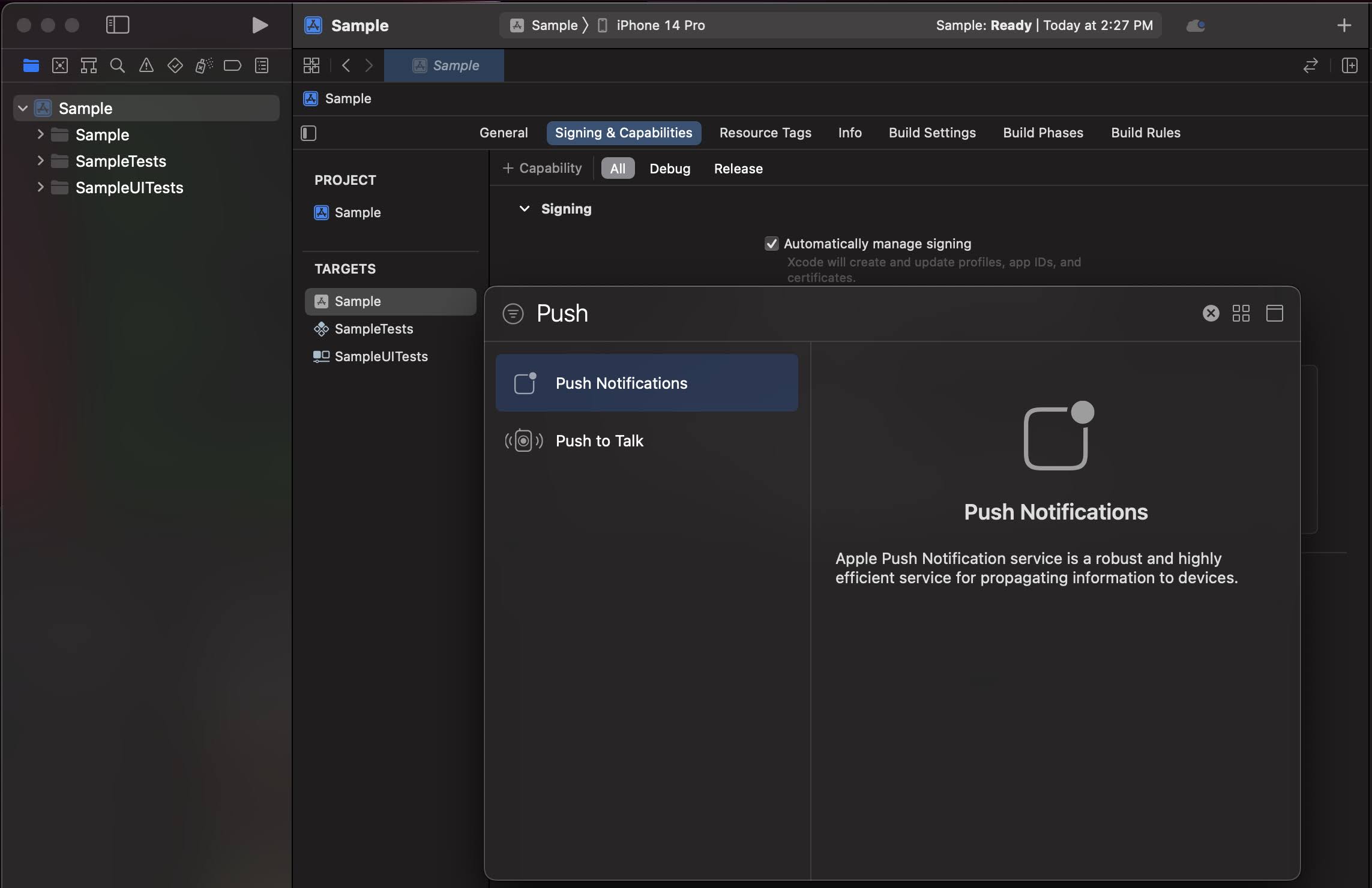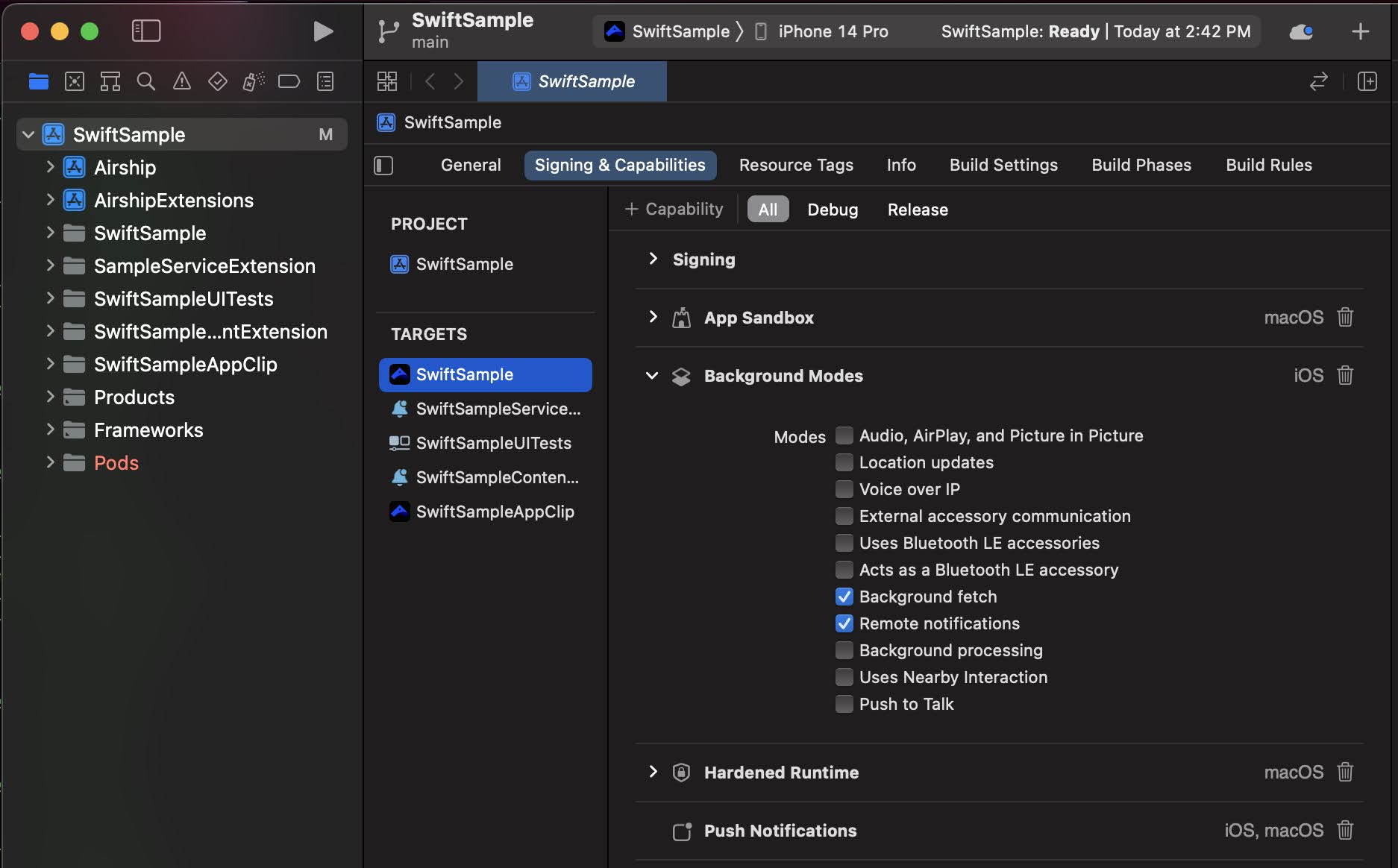Capacitor Plugin Setup
How to install the Airship Capacitor plugin.
Requirements
iOS:
- capacitor >= 5.0.0
- Requires Xcode
15.2+ - Minimum iOS version supported
14+ - To use notifications:
Android:
- capacitor >= 5.0.0
- Minimum Android version supported
21+ - Compile SDK version and Target SDK version
34+ - To use notifications:
Setup
Install the plugin
npm install @ua/capacitor-airship
npx cap synciOS Setup
Use Xcode to enable push notifications in the target’s Signing & Capabilities pane:
Open your project in Xcode.
Click on your project in the Project Navigator.
Select your main app target and then click the
Signing & Capabilitiestab.If you do not see Push Notifications enabled, click
+ Capabilityand addPush Notifications.
Next enable background notifications in the target’s Signing & Capabilities pane:
Select your main app target and then click the
Signing & Capabilitiestab.Click
+ Capabilityand addBackground Modes.
In the
Background Modessection, select theRemote notificationscheckbox.
Notification Service Extension
To take advantage of notification attachments, such as images, animated gifs, and video, you will need to create a notification service extension .
Follow the steps in the iOS Notification Service Extension Guide.Initialize Airship
Before you can access any of the module’s API, the Airship module needs to be initialized.
This can be accomplished by calling takeOff when the device is ready with the proper config or by providing plugin config in the capacitor.config.json file.
// TakeOff
await Airship.takeOff({
production: {
appKey: "<APP_KEY>",
appSecret: "<APP_SECRET>"
},
development: {
appKey: "<APP_KEY>",
appSecret: "<APP_SECRET>"
},
inProduction: true,
site: "us", // use "eu" for EU cloud projects
urlAllowList: ["*"],
android: {
notificationConfig: {
icon: "ic_notification",
accentColor: "#00ff00"
}
}
}){
"appId":"com.example.plugin",
"appName":"example",
"bundledWebRuntime":false,
"webDir":"dist",
"plugins":{
"SplashScreen":{
"launchShowDuration":0
},
"Airship":{
"config":{
"default":{
"appKey":"<APP_KEY>",
"appSecret":"<APP_SECRET>"
},
"site":"us",
"urlAllowList":[
"*"
],
"android":{
"notificationConfig":{
"icon":"ic_notification",
"accentColor":"#00ff00"
}
}
}
}
},
"server":{
"androidScheme":"https"
}
}
}Takeoff can be called multiple times, but the config passed in takeOff won’t be applied until the next app init.
URL Allowlist
The URL allowlist controls which URLs the Airship SDK is able to act on. The SDK divides up usages of URLs into three different config options:
urlAllowListScopeOpenUrl: Only URLs allowed for this scope can be opened from an action, displayed in landing page, displayed in an HTML in-app message, or displayed as media in an In-App Automation. Defaults to any Airship-originated URLs and YouTube URLs.urlAllowListScopeJavaScriptInterface: These URLs are checked before the Airship JavaScript interface is injected into the webview. Defaults to any Airship-originated URLsurlAllowList: Both scopes are applied to these URLs.
<pattern> := '*' | <scheme>'://'<host>/<path> | <scheme>'://'<host> | <scheme>':/'<path> | <scheme>':///'<path>
<scheme> := <any char combination, '*' are treated as wild cards>
<host> := '*' | '*.'<any char combination except '/' and '*'> | <any char combination except '/' and '*'>
<path> := <any char combination, '*' are treated as wild cards>To accept any URL within the SDK, set the urlAllowList to ["*"].
Implementation best practices
Make sure to set up logging. Internal logging can be valuable when troubleshooting issues that arise when testing.
Anytime you make any changes or updates to the SDK, test on a development device to ensure your integration was successful. Also make sure analytic information is still flowing to your Airship project before sending the app to production.
Categories
